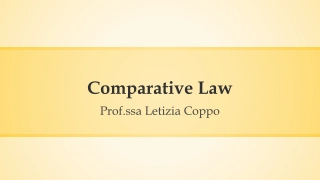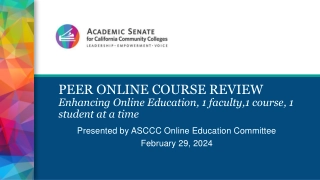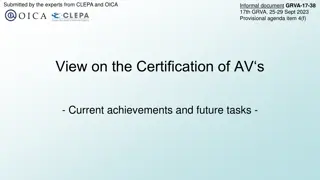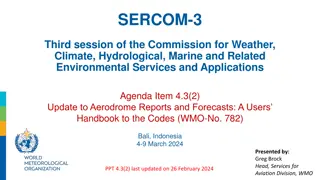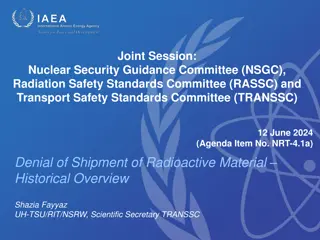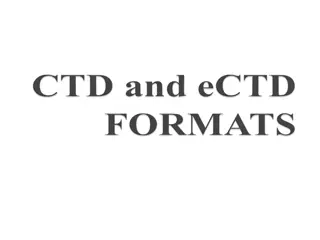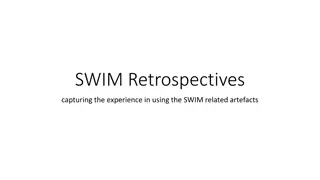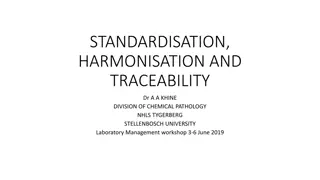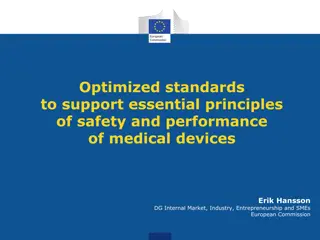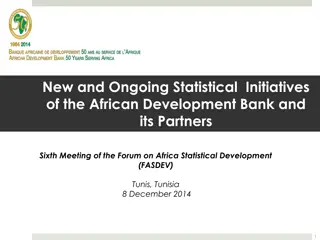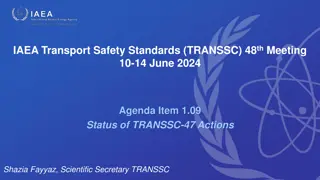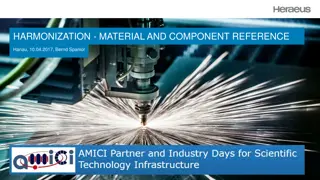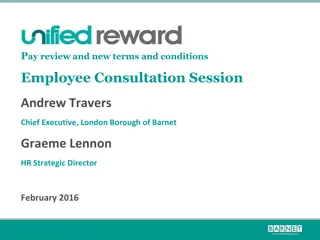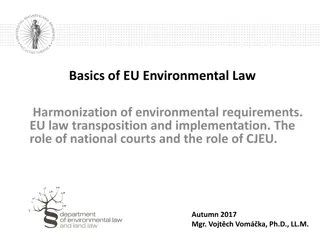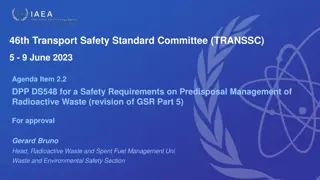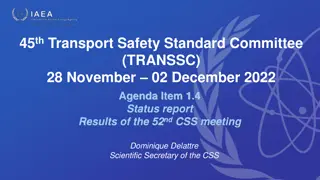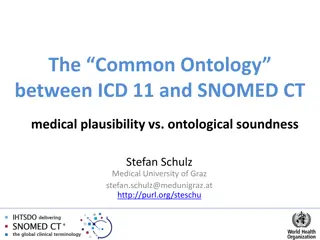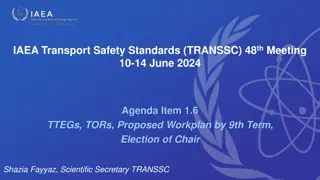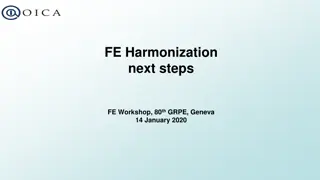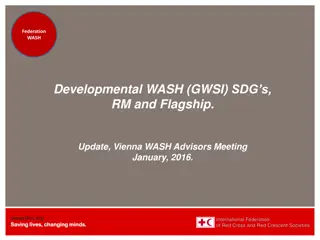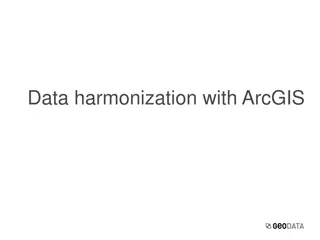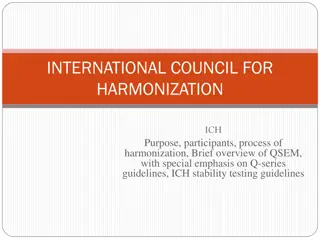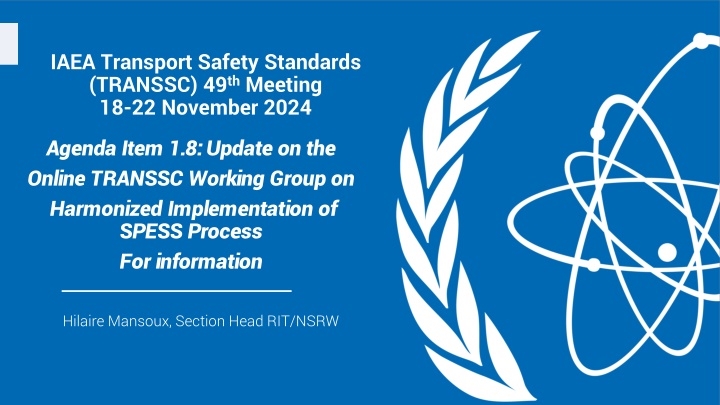
Update on Online TRANSSC Working Group for Harmonized Implementation of SPESS Process
Stay informed about the latest developments in the TRANSSC Working Group focusing on harmonizing the implementation of the SPESS process. Learn about the composition and aim of the group, its current status, and the reasons driving the need for updates now. Discover the challenges faced and the valuable contributions of TTEGs and WGs to the TRANSSC. Stay updated on the progress and decisions made in the TRANSSC community.
Download Presentation

Please find below an Image/Link to download the presentation.
The content on the website is provided AS IS for your information and personal use only. It may not be sold, licensed, or shared on other websites without obtaining consent from the author. If you encounter any issues during the download, it is possible that the publisher has removed the file from their server.
You are allowed to download the files provided on this website for personal or commercial use, subject to the condition that they are used lawfully. All files are the property of their respective owners.
The content on the website is provided AS IS for your information and personal use only. It may not be sold, licensed, or shared on other websites without obtaining consent from the author.
E N D
Presentation Transcript
IAEA Transport Safety Standards (TRANSSC) 49th Meeting 18-22 November 2024 Agenda Item 1.8: Update on the Online TRANSSC Working Group on Harmonized Implementation of SPESS Process For information Hilaire Mansoux, Section Head RIT/NSRW
WG Composition and Aim WG members Mr Samir Sarkar Australia to define a common path forward to ensure that TRANSSC operates as an independent review committee fully aligned with the Terms of Reference (ToRs) of Safety Standards Review Committees (SSCs) and to identify ways to benefit from TTEGs Mr Jeff Ramsay Canada Mr Xianbo Fang - China Mr Fabien Feron France Ms Anne Endres Germany Mr Masakazu Shima Japan Ms Fadoua Hatimi - Morocco Mr Majid Akhtar Pakistan Mr Faisal Alrumayan Saudi Arabia Mr Manuel Garcia Leiva Spain 2 On-line Meetings: 4 September 2024 Mr Michael Wallin Sweden 31 October 2024 Mr Frank Koch Switzerland Ms Tuba Ecevit T rkiye 1 In-person meeting planned: 19 Novembre 2024, 4 pm room C0343 Mr Christopher Jones UK Mr Rick Boyle - USA Mr David Pstrak TRANSSC Chair, USA NSRW + NSOC Staff IAEA Secretariat
WG status Working Progress Secretariat explaining what to change, why, why now Secretariat explaining the boundaries, and making proposals MS representative sharing their views Only one clear decision agreed: SSR6- Rev 2 finalization should and will not not be impacted Full transparency with TRANSSC, meeting reports and presentations available CSS informed last week; status report will be presented in May 2025
Why Now ? New TRANSSC Term New TRANSSC Members TRANSSC Chair and Scientific Secretary now familiar with the process and experienced This Term to discuss and decide, next Term to implement
TTEGs, TRANSSC WGs Very valuable contribution, support and benefit to TRANSSC, to SSR-6 review/revision specifically The challenges they represent for the Secretariat: Standing bodies, ongoing mandate, no time-limited tasks, not aligned with the concept of ad-hoc working groups in the SSCs ToRs Not formally open to all MS, only groups from the TRANSSC community, no fair involvement of all MS Duplication of ad-hoc WGs, CS, TM, that secretariat (TO) would call for specific topics, based on issues raised and needs expressed, like the joint RASSC/TRANSSC A1/A2 WG Preclude cooperation with other committees by creating joint working groups Contributions on draft safety standards during and between TRANSSC meetings not aligned with SPESS B sequential steps and leading to TRANSSC having a drafting role, and not just a reviewing role Put at risk the independent review of the drafts by TRANSSC Bypass/take the roles of the Secretariat (TO, Coordination Committee) MS and Secretariat cannot be in all groups, as they run in parallel
Alignment with SPESS B The sequence of steps has a purpose: clarifying roles, time and expected outcomes For example, feedback and gap analysis must be completed at Step 3, to focus and streamline follow-up work and discussions For example, NS department Coordination Committee reviews at step 6 and at step 10 should not be by-passed or interfered with. For example, issue of TRANSSC 48 not being invited to discuss some topics still being under work in the resolution table: TRANSSC (including its TTEGs and WG) cannot interfere in the resolution table preparation by the Secretariat (Responsibility of the TO); it would impact what other SSCs see after MS comments, it interferes with the roles of the TO, the Coordination Committee
TRANSSC Member, Alternate Member, Experts 1 Member, 1 Alternate, as many experts as needed for each Member State Different roles during and between TRANSSC meetings (see meeting 1 report) Importance of preparatory work between TRANSSC meetings with key coordination role of the Member to elaborate and then present the MS position Each Member State representative is expected to present a national position on IAEA safety standards, which should be based on appropriate consultation at the national level and coordination of the input of national interested parties. However, each member may be supported at the meetings by (an) advisor(s) including other national government representatives, national industry representatives or interested parties. Experts are invited to play their role as mentioned in ToR of SSC before, during and after TRANSSC meetings, independently of TTEGs and WG
Additional Points SSCs ToRs and SPESS documents (implementing the 1995 GOV/INF/772 and its 2001 revision GOV/INF/2001/1) are subject to periodic reviews/revisions, so that they remain valid and applicable SPESS B and ToRs revised in 2023; latest update to the BoG with GOV/INF/2015/9; revision of SPESS A to be initiated TRANSSC is the lead committee for SSR-6, but other SSCs have the same authority at some steps, like STEP 11 Discussions on technical topics, contributions of experts are critical and will not stop, they should be organized differently and harmonized with other SSCs.
Way Forward, IAEA Secretariat proposals IAEA intention is to stop the current TTEGs and WGs at the latest by the end of this term The 7 topics currently covered (plus any others) by TTEGs and WGs could be discussed in TRANSSC 50/51 and, if needed, with all MS, with a view to: assess their relevance / need / priority replace them gradually by classic IAEA ad-hoc working groups of TRANSSC Members, supplemented by Consultancies/Technical Meetings where experts would comes, with all relevant experts This shift is not meant to stop experts coming to TRANSSC meetings, to support their Member As of TRANSSC 50, no more TTEGs and WG meetings in the middle of TRANSSC. TRANSCC will run over 3 consecutive days

